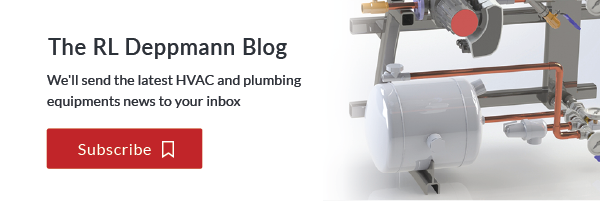 DriSteem Humidifier Company created the Drane-kooler™ to solve the problem of eliminating the steam condensate created from the heating of steam humidifier tubes and separators. We are often asked about using a single Drane-kooler for multiple humidifiers. Here is the answer.
DriSteem Humidifier Company created the Drane-kooler™ to solve the problem of eliminating the steam condensate created from the heating of steam humidifier tubes and separators. We are often asked about using a single Drane-kooler for multiple humidifiers. Here is the answer.
What is the Drane-kooler?
A Drane-kooler is a condensate cooler created by DriSteem Humidifier Company. It uses city water which mixes with hot condensate, both are then discharged to drain below 140°F, complying with most codes and low enough for use with a PVC drain pipe. The non-electric thermostatic control valve sensor allows the right amount of cold water when required and closes when there is no hot condensate to save water.
What is the Capacity of the Drane-kooler?
The unit will cool 6 GPM of condensate at 212°F down to 140°F using 6 GPM of 70°F water. At that rate, the total volume required for the drain is 12 GPM. The water pressure to the Drane-kooler should be between 25 and 75 PSIG.
6 GPM of condensate is the equivalent of about 3000 PPH of 0 PSIG steam. We know that most of the steam goes into the duct for humidification, but how much do we lose to heat loss?
Heat Loss through DriSteem Humidifiers
DriSteem has engineered a high-efficiency PVDF insulation to assist you in your quest to save energy. In addition to energy savings, the material used at DriSteem to insulate is approved for use in plenums, will not absorb water or support microbial growth, is odor free, and is resistant to UV light. But let’s focus on the energy saving. The standing heat loss through humidifiers using DriSteem high-efficiency insulation is only about 5% of the load.
Two quick examples. First, a multiple tube humidifier was recently installed at a hospital. It had a load of 433 PPH and the total with losses is 458 PPH. Another example, an Ultrasorb humidifier had a load and total of 1285 and 1364 PPH.
These represent losses that are very small. 100 PPH would be 0.2 GPM of condensate. This would lead us to believe we could put 20 or 30 units on a single Drane-kooler. But there is more.
Heat Required or Start-up Load and the DriSteem Humidifiers
One area I looked at was the start-up load. When the humidifier is in the duct at 50°F and it is called into action, what is the load to heat it up to 212°F? This is all about weight and specific heat. We have to take the weight of the tubes and pipe in the humidifier up to temperature. The more metal in the tubes, the more steam is needed to heat and the more condensate is created as a result.
If we look at the total weight of an Ultrasorb panel style humidifier, most of it is in the frame to hold everything together. About 1/3 of the weight is the tubes themselves. So how many humidifiers can we pipe into a single Drane-kooler? It’s all about weight. Here is a simple table to get you close.
| Humidifier Weight | Number of units per Drane-kooler |
| 200 lbs. | 1 |
| 100 lbs. | 2 |
| 50 lbs. | 4 |
This is a safe table. If you want the answer to a specific application, contact R. L. Deppmann or your local DriSteem representative.
Note: If you are using the Drane-kooler for the drain down from our electric or steam generators, do not use more than one without contacting your representative to make sure the sizing is correct.
Other Uses for the Drane-kooler
We have sold this handy product for other applications. For example, a healthcare sterilizer is added in an area where the condensate return main is not available and the owner is willing to lose the water and energy in the condensate. Good use for a Drane-kooler.
Other uses might include boiler blowdown, sample cooler, or on any application where condensate is being discharged to drain or waste.
Don’t forget the proper piping with the air gap!
Here are links if you need more information on the Drane-kooler product:
Look forward to another new subject in the next R. L. Deppmann Monday Morning Minutes.


